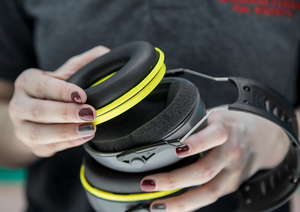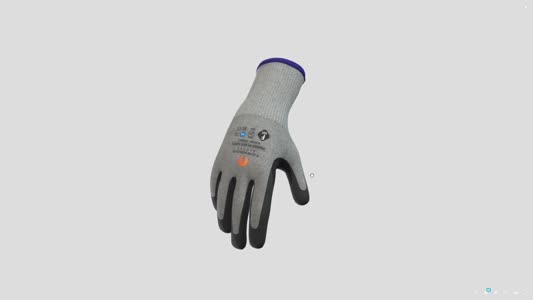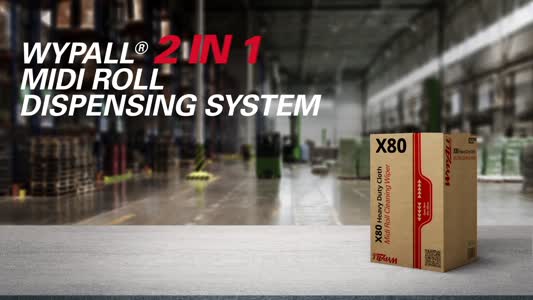
 |
Mark Sennett
Managing Editor |
 |
Kelly Rose
Editor |
| Home> | PPE | >Ear Protection | >Hear today, hear tomorrow |
Hear today, hear tomorrow
28 September 2025
NOISE DOES not have to be loud to cause damage. Louise Charlton explains the risks of noise exposure and the solutions to prevent long term hearing damage.

You may not notice it, but noise exposure adds up. Noise can become so familiar it fades into the background. However that does not make it harmless.
“Hearing loss is a long latency condition”, explains Jason Reynolds, JSP’s hearing protection specialist. “Most of us know someone with hearing impairment, so we understand the challenges they face on a daily basis. It’s the simple things that are missed the most, like basic communication or the ability to talk to kids or grandkids, yet in many cases protection is not taken seriously enough.”
Following the hierarchy of controls, employers should first seek to eliminate or reduce the risk by introducing a ‘buy quiet’ policy and modifying equipment to lower sound output levels. Limiting exposure time also helps – halving the time spent in a noisy area reduces exposure by 3 dB. Hearing protection acts as a last line of defence to bring residual noise to a safe level.
Throughout 2025, the Health and Safety Executive (HSE) are focusing on workplace hearing protection. Despite The Control of Noise at Work Regulations being in place for over 20 years, inspections show that a lack of training continues to put people at risk. A recent discussion with industry stakeholders revealed the extent of the problem:
81% of employees didn’t know how to check their hearing protection before use
80% of employees had no training on fitting and compatibility issues
18% of duty holders did not assess if hearing protectors offered adequate attenuation
The HSE are educating employers and staff on best practice, promoting a simple message with the ‘CUFF’ acronym:
C – Condition. Is the hearing protection in good condition?
U – Use. Are workers using hearing protection when it is needed?
F – Fit the ear. Is the hearing protection fitted properly?
F – Fit for purpose. Has the hearing protection been correctly specified?
Checks and maintenance
Through recent site visits, the HSE found ear defenders with missing foams, torn cushions and broken headbands. The Noise Regulations require employers to implement a system for reporting defects and damage, however speaking to employees revealed 74% did not know how to report problems with their hearing protection.
Training should cover how to check equipment before use and report defects that may affect performance. If the ear defender headband is stretched, especially during storage, it can become loose and reduce attenuation. Compressing the cushions affects how they fit around the ear. Some cleaning products damage the cushion surface material, preventing a tight seal.
Disposable earplugs are only intended for a single shift before being replaced. Beyond hygiene concerns, they often do not offer the same protection when re-used. Reusable earplugs must be cleaned and stored properly to prevent damage.
Ear defenders are maintainable with spare cushions and inner foams to replace damaged components. Keeping your hearing protection in good condition extends its usage life. Clean, well-maintained equipment is also more comfortable and user-friendly which increases wearer compliance.
Hearing protection usage
PPE can only protect you when it is worn. Removing ear defenders or earplugs for just a few minutes significantly reduces protection, potentially putting exposure above the legal limit.
Discussing usage, we found 37% of wearers had not been told how important it is to use hearing protectors continuously in a noisy environment. Designating hearing protection zones (HPZs) lets staff know that appropriate protection must be worn at all times within the area. Some sites specify ear defenders for their visibility advantage, making it easier to check they are being worn when they should be.
The Noise Regulations require employers to provide comfortable, easy-to-use hearing protection, consulting with employees to assess suitability. It must allow work to be carried out safely without impeding the wearer or introducing additional risk. Involving staff in selection helps to ensure equipment is suitable for all wearers and the work environment.
Does it fit?
Hearing protectors need to fit in order to perform properly. Ear defenders and earplugs form a barrier between the inner ear and external noise source. However, without a tight seal, leaks can compromise protection.
Fit testing assesses how well hearing protectors fit individual wearers. Commercially available systems calculate a Personal Attenuation Rating (PAR), offering a more accurate idea of protection in a workplace setting, but this only reflects performance when correctly fitted.
Employers are responsible for training staff in how to fit and wear hearing protectors, as well as any limitations of the equipment. It is important to follow the manufacturer’s instructions, making sure earplugs are fully inserted, and ear defenders fit tightly completely covering the ears with no gaps around the seal.
Hair, earrings and clothing can interfere with hearing protector fit. Wearing ear defenders over a hoodie, for example, significantly reduces protection. The cushions need to seal tightly around the ears to stop noise leaking in. Eyewear also affects fit. Studies have shown that spectacle frames fitted under ear defender cushions limit protection by 3.5-8.5 dB, while large goggles reduce the SNR by up to 10 dB.1
Certified compatibility
When using helmet or faceshield mounted ear defenders, it is crucial to check equipment has been tested and certified together. EN 352-3 requires ear defenders to be fitted to compatible products for testing. Attaching them to a different helmet may not offer the same attenuation.
Certification ensures equipment continues to perform at the same level. After testing, approved combinations are listed on the ear defender type examination (CE/UKCA) certificate and monitored for ongoing conformity. Without certified compatibility, changes to either product can affect performance and compromise protection.
Specifying attenuation
Noise exposure is based on decibel level and time. While very loud sounds can cause instant hearing loss, often damage occurs slowly as a result of prolonged exposure. The workplace exposure limit is a daily/weekly average of 87 dB(A), with a further two ‘exposure action values’ calling for different control measures.
In practice it may be difficult to tell whether an area is too noisy. If you need to shout to be heard by colleagues approximately two metres away, this suggests a workplace noise problem and a risk assessment should be arranged.
The aim when selecting hearing protection is to achieve an average exposure of 70-80 dB. Attenuation must be high enough to reduce noise, but overprotection can present a more immediate danger.
A high SNR may prevent the wearer from hearing fire alarms or approaching vehicles. However when asked about audibility assessments, 95% of employers said they did not check warning sounds could be heard when issuing hearing protection. To avoid overprotection, choose an SNR as close as possible to the required level and conduct an audibility check to ensure equipment is safe for use.
The ongoing HSE inspections emphasise the importance of education and training. With an understanding of noise hazards and control measures, employers are able to manage hearing protection more effectively and provide training to ensure it is used and maintained in the correct way. ‘Hearing is essential for quality of life’, says Jason. ‘Think SNR, audibility, maintenance. Protect your ears before it’s too late.’
Louise Chalton is technical copywriter at JSP Safety. For more information, visit jspsafety.com.
Notes:
Percentage data gathered from 2024 HSE inspection findings presented in stakeholder meeting.
1. HSE Research Report RR720 (2009) Real world use and performance of hearing protection.
- Manufacturing under Kitemark scheme
- Low weight bump cap
- Face-fitting made easy
- Fog-free vision
- Head and eye protection become one
- Detectable protection with integrated structural comfort
- Disposable respirator offers durability
- Sound advice
- Road traffic separators
- High-performance electrical protection

























